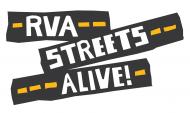
Image from NACTO.
If you’ve been reading your occasional dose of bikeablerichmond.com posts like a good boy or girl, then you know that the city is pursuing a bicycle master plan to supplement the bicycle component of Richmond Connects, a multi-modal transportation plan that has been in development for a couple of years now. (See previous posts on Richmond Connects and the bicycle master plan here and here).
Given how soon (in bureaucratic time) the UCI World Cycling Championships are coming and how much the city would like to put forward a bike-friendly face to those thousands of visitors and television viewers, it makes sense to get going on some projects even before the bicycle master plan is finished and approved.
Enter the Floyd Avenue bicycle boulevard (already included in Richmond Connects)! Although it was on the agenda at the last city council meeting it did not spark much discussion because council was only asked to approve a resolution allowing the city to seek approval from the Commonwealth Transportation Board. The project got a bit more attention a couple of days ago, however, when local political blog Bacon’s Rebellion included a very supportive piece on the project.

Example of bicycle boulevard infrastructure in Long Beach, CA. Image from bikelongbeach.com.
What is a bicycle boulevard? Basically it is a low-volume street that is redesigned to give priority to bicycles. So, unlike a bike lane or cycle track, a bicycle boulevard does not create a separate space for bicycles per se, but instead makes the whole street better for cycling by prioritizing bicycles.
Usually this is done by adding features that both slow car traffic and in some cases divert it to other streets. Think of it as major traffic calming with bicycles in mind. People who live on Floyd will be able to drive up to their homes and park on the street just like they always do; but motorists would have to use Grove or another parallel street to get through the Fan. The Fan is a perfect place for a bicycle boulevard precisely because there are plenty of parallel streets that provide an alternative.
Perhaps not surprisingly, Jim Bacon’s post sparked some discussion that gives us a taste of the debate that will ensue when the project is discussed in neighborhood associations and other public forums. The main critical points so far include: 1) Why should we make things safer for cyclists when they break the law all the time? 2) Why spend money on this if the street is already low-volume? 3) Bike infrastructure ghettoizes cyclists and will convey the idea that they don’t belong on other streets. Why not just slow traffic down everywhere? 4) What about fire trucks and other larger vehicles that need to get through?
1) Hopefully you know the drill in response to the first one: Do we argue against infrastructure for cars by citing statistics on how many drivers fail to stop completely at stop signs, exceed the speed limit, text while driving, blow through the intersection just after the light has turned red, etc. etc.? Would we accept the argument that we should not install crossing signals for pedestrians because many of them jaywalk? No. Education and enforcement for cyclists is completely unrelated to whether we should build infrastructure for them. Let’s move on.
2) The second point is more serious. The simple answer is: Floyd and similar streets are still not calm enough to get a lot more people to use a bicycle for transportation. The goals of this and other infrastructure are to make things safer, but also to encourage more bicycling by providing a low-stress environment — a greater sense of safety. Another crucial thing here is that Floyd will eventually be part of a city-wide network of various bikeways. It should be judged not just on its specific merits but also as one part of a growing network.
3) I would love citywide traffic calming, but I doubt that in the foreseeable future the city will be willing to put a 20 mph limit on Broad Street and invest the resources required to enforce it or totally redesign the street. I also think that, a few cranky people aside, drivers will come to accept that cyclists sometimes have to use streets other than the ones specifically set aside for them. More bike infrastructure, along with other efforts, will change the culture in Richmond over time.
4) I don’t have the engineering background to weigh in here in great detail, but if making Floyd a bike boulevard would make it impossible for emergency vehicles to get to a house there, I can only assume it will not be done. As it is, many U.S. cities, including Los Angeles, have installed bicycle boulevards in recent years without this issue standing in the way.




